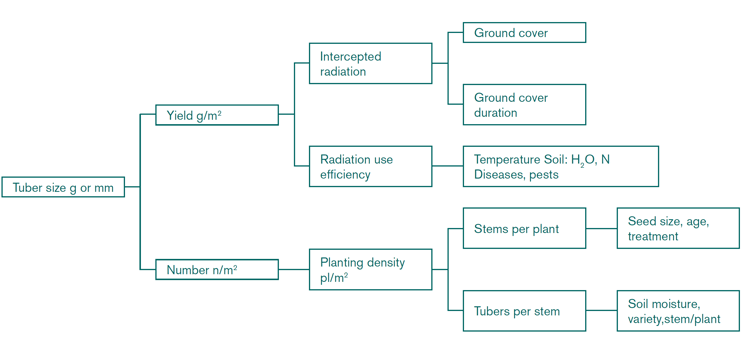When planting a potato field, a certain surface area of skin of tuber is planted on which there are a number of eyes. These eyes produce none, one or two sprouts. Nonetheless, the planting rate is not expressed as the number of potentially stem producing sprouts but as the number or seed tubers and a seed rate expressed as weight planted per unit area. The latter is most practical and most commonly used in combination with the tuber size. A farmer knows the size of the field, knows the planting pattern (distances between rows and between tubers within the row) so knows the number of tubers and orders a certain amount of seed of a certain size to approximate the need.
An average practice of many potato production systems is planting 4 tubers per m2 weighing 55 g each, resulting in a seed rate of 2.2 t/ha. This practice, on average for many varieties, if the seed is well sprouted, results in 16 stems per m2. If the seed has barely sprouted with an apical dominant sprout, the number of stems is less. This is also the case when the seed is very old. Planting smaller seeds results in less stems per plant and larger seed tubers yield more stems per plant. A higher number of stems per plant assures an earlier crop cover, more intercepted solar radiation over the season and consequently a higher yield. More stems per plant lead to more tubers per plant but due to increased competition yield is more decreased than tuber number resulting in on average smaller tubers. Since a smaller tuber size is desired for seed tuber production purpose than for table potatoes, the seed rate there is higher to result in about six plants per m2 or 24 stems per m2.
Aiming for desired yield
To aim at a desired yield of a specific average tuber size, implies that the grower needs to influence the number of tubers grown per unit area. This number increases by planting more seed tubers or pieces, so at less space between the rows and or less space between the tubers within the row, larger seed tubers and multiple sprouted seed tubers. All these measures, however, counteract because of competition for nutrition from the mother tuber (sugars) or from the environment (light, water and nutrients). The larger the riddle size, the higher the weight of the seed tuber. The larger the length-towidth ratio, the higher the weight of the tuber of the same riddle size because the width is taken as the size. A round tuber of 25 mm weighs about 10 g but a long shaped one about 13 g, a round tuber of 50 mm weighs 60 g and a long one 80 g. Therefore, the tuber number of one ton of long tubers is considerably less than of round tubers. This is taken into account when a grower adjusts the planting distance of a planting machine. So, yield and riddle size of the crop all have an optimum for each growing condition (environment and management practices) and desired product (small or large tubers). The quantity of harvested tubers and their size depend on the seed size at similar rate and the seed rate at similar size. The number of stems per m2 increases from around 10 to 40 with seed rate from 500 kg to 4000 kg per hectare. Also a seed size increase from 10 to 120 grams leads to more tubers per plant from 10 to 20 and to higher yields from 20 to 50 t/ha. It does, however, lead to less tubers per stem from 5 to 2 and to smaller riddle sizes from average 6 cm to 3 cm. All figures are examples merely and depend much on variety, environment and management. Ware potato growers in all production regions follow the general rules of described above. Growers plant 4 plants per m2 of seed tubers or seed pieces of around 60 g amounting to a seed rate of around 2.5 t/ha. Dedicated seed growers aim at harvesting a greater number of tubers per unit area as small and intermediate seed sized tubers. They follow two strategies: harvest prematurely before most tubers have exceeded the desired size which they need to do anyway because of increased vector pressure, i.e.aphids transmitting viruses. Another strategy is planting at greater density, so at narrower spacing within the row.
Higher seed rate
Seed crops in general are planted at 6 plants per m2 instead of 4 plants per m2. A higher seed rate (more seeds and larger seed with consequently more stems per unit area) yields smaller daughter tubers. Actual seed bulking rates from one season to another are not the same in all production systems. Where tubers are allowed to grow large up to maturity and are cut into smaller pieces (e.g. in the USA), the multiplication rate is higher than where a highdensity crop is harvested prematurely (e.g. in the Netherlands). The latter means of growing seed tubers permits more field multiplication as per season the disease pressure is reduced by reduced exposure time.

Tuber size increases with higher yield and lower tuber numbers. A higher yield is achieved by capture of more solar radiation and fewer tubers are produced by factors that contribute to fewer stems and fewer tubers per stem.
For more figures to illustrate the plant density of the potato field, and to keep reading about the potato crop and decisions at planting, check our Potato handbook.
Our Potato handbook is a global potato university in 1 book!
Buy your copy today and get a one-year free subscription to PotatoWorld magazine.

